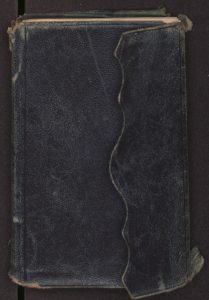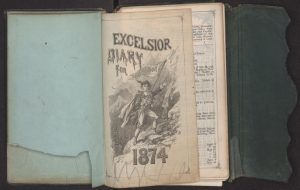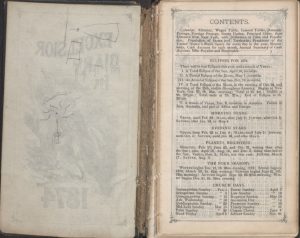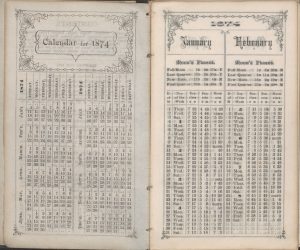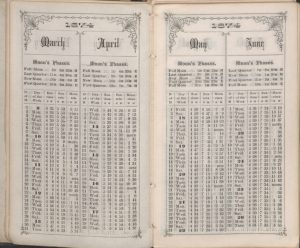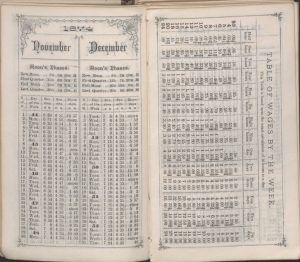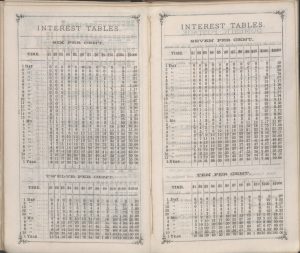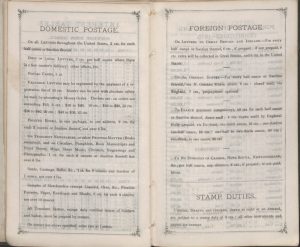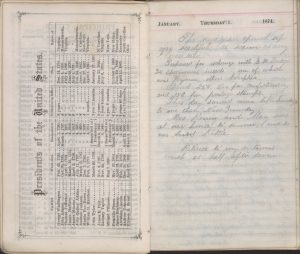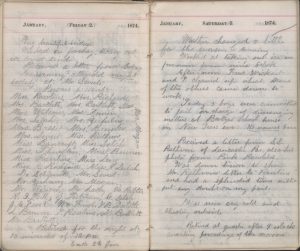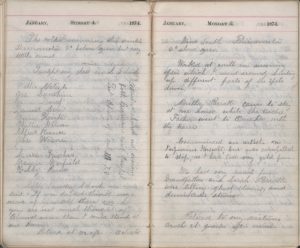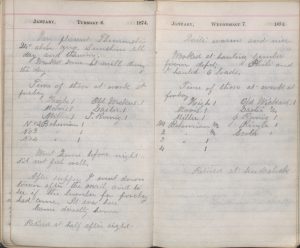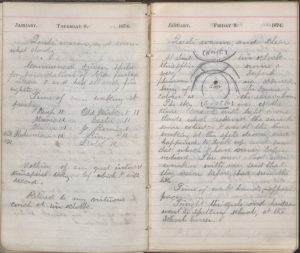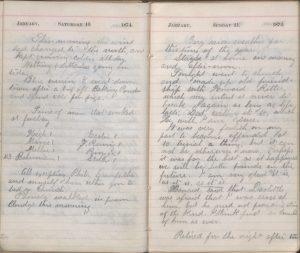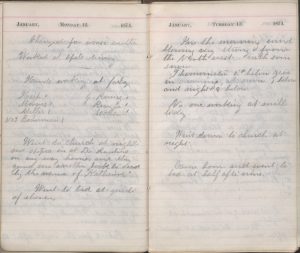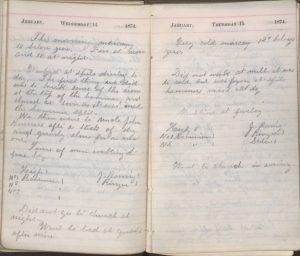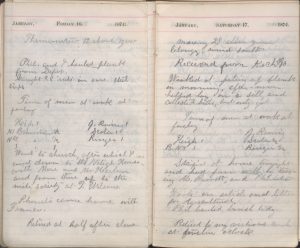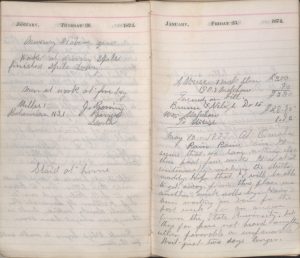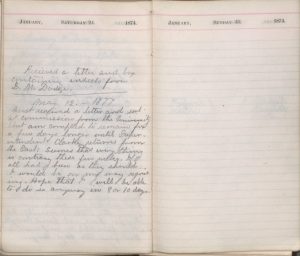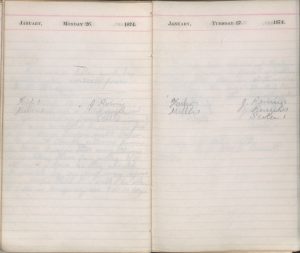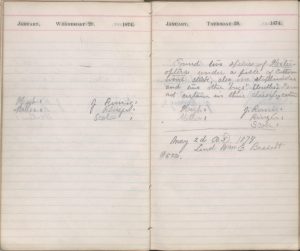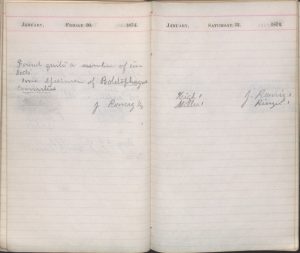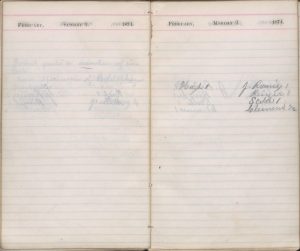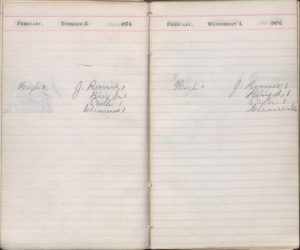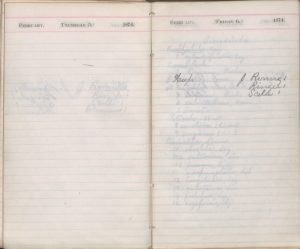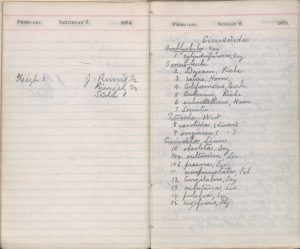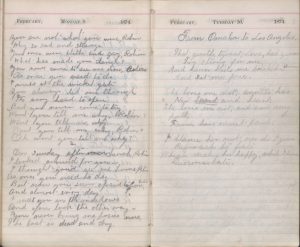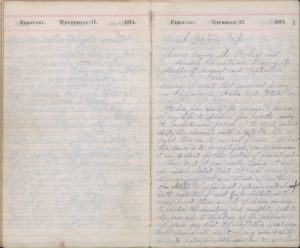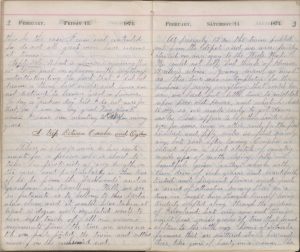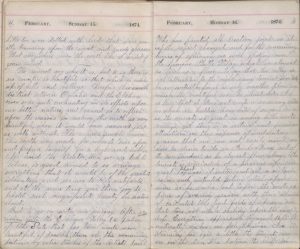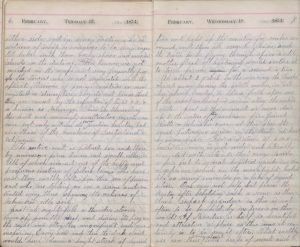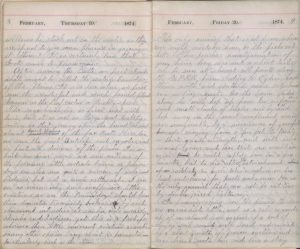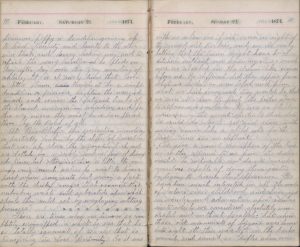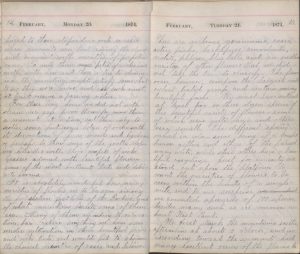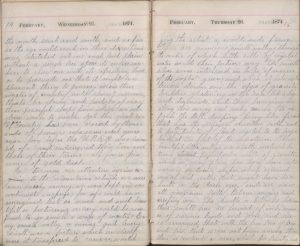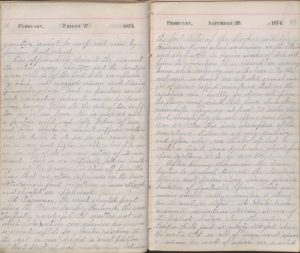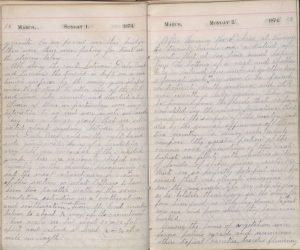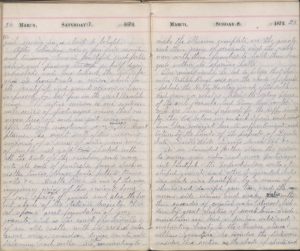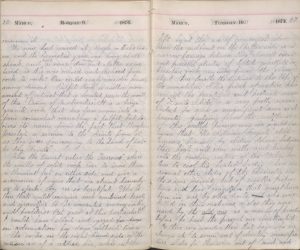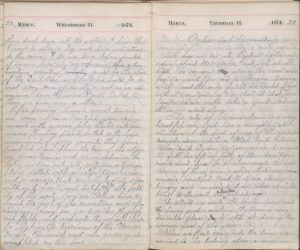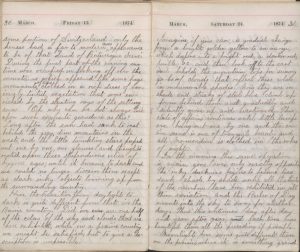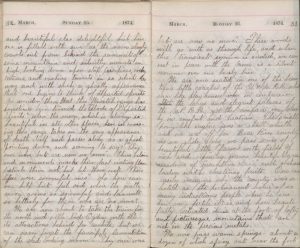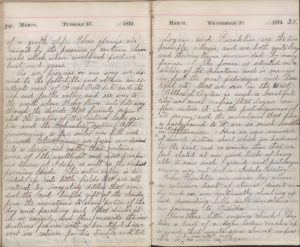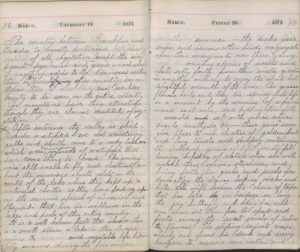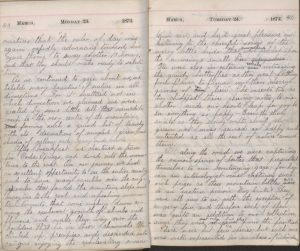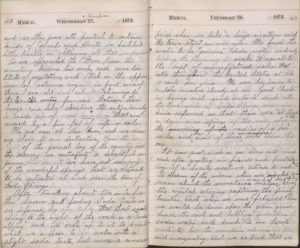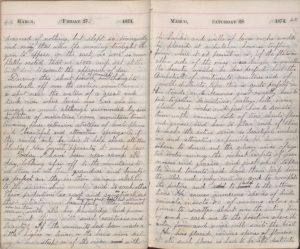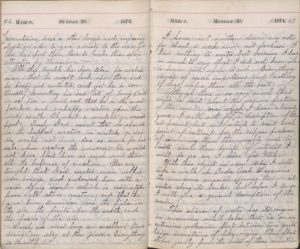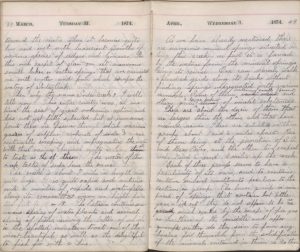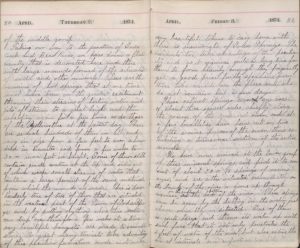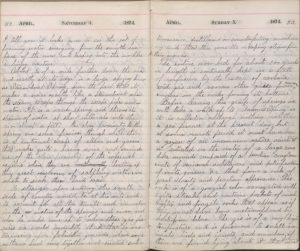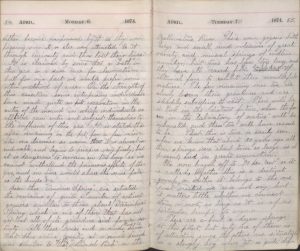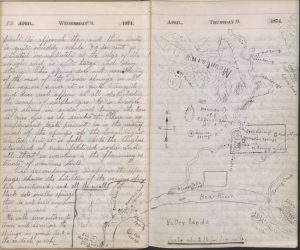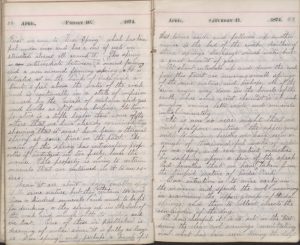Great Nebraska
Naturalists and ScientistsLawrence Bruner, Fieldnotes, 1874, Part 1
Front End Paper
Contents
CONTENTS.
Calendar, Almanac, Wages Table, Domestic Postage, Foreign Postage, Stamp Duties, Principal Cities, their Distance from New York, with Difference in Time and Population; Population of States and Territories, Presidents of the United States, a Blank Space for every day in the year, Memoranda, Cash Account of each month, Annual Summary of Cash Account, Bills Payable and Receivable.
ECLIPSES FOR 1874.
There will be four Eclipses this year, and a transit of Venus:
I. A Total Eclipse of the Sun, April 16, invisible.
II. A Partial Eclipse of the Moon, May 1, invisible.
III. An Annular Eclipse of the Sun, Oct. 10, invisible.
IV. A Total Eclipse of the Moon, in the evening of Oct. 24, and morning of the 25th, visible throughout America. Begins at New York, Oct. 25, 0h 45m. morning; Total at 2 h. 4m.; Middle at 2h. 20 1/2 m.; Total ends at 2 h. 37 m.; End of Eclipse at 3h. 55 1/2m.
V. A transit of Venus, Dec. 8, invisible in American. Visible in Asia, Australia, and park of Africa and Europe.
MORNING STARS.
Venus, until Feb. 23; MARS, after July 5; Jupiter, after Oct. 5; SATURN, after Jan. 24 to May 4.
EVENING STARS.
Venus, from Feb. 23 to Dec. 8; MARS, until July 5; JUPITER, until Oct. 5; SATURN, until Jan. 24, and after May 4.
PLANETS BRIGHTEST.
MERCURY, Feb. 27, June 23, and Oct. 21, setting then after the Sun; also, April 18, Aug. 16, and Dec. 5, rising then before the Sun; VENUS, Nov. 2; MARS, not this year; JUPITER, March 17; SATURN, Aug. 3.
THE FOUR SEASONS.
WINTER begins Dec. 21, 0h. 36 m. evening, 1873; SPRING begins, 1874, March 20, 1h. 42m. evening; SUMMER begins June 21, 10h. 12m. morning; AUTUMN begins Sept. 23, 0 h. 27m. morning; Winter begins Dec. 21, 6h. 26m. evening.
CHURCH DAYS.
Septuagesima Sunday…Feb. 1Easter Sunday…April 5Sexagesima Sunday…” 8Low Sunday…” 12Quinquagesima Sunday…” 15Rogation Sunday…May 10Ash Wednesday…” 18Ascension Day…” 14Quadragesmia Sunday…” 22Pentecost Sunday…” 24Mid-Lent Sunday…Mar. 15Trinity Sunday…” 31Palm Sunday…” 29Corpus Christi…June 4Good Friday…April 3Advent Sunday…Nov. 29
January 1
January, Thursday 1., 1874.
The new year opened up very beautful, as warm as any I ever saw.
Prepaired for exchange with G.M. Dodge 24 Specimens insects, one of which was Hoymen; other Coleophila.
Spend 25 [cents]: ten for confectionary and 15 [cents] for postage stamps.
‘
This day seemed more like Sunday to me that New Years-day.
Mrs. Rossig adn Mary were at our house to dinner, I and so was ? Kittie.
Retired to my virtuous couch at half after seven.
January 2 - 3
January, Friday 2., 1874.
Very beautiful indeed.
Worked in forebay, taking out ice and sand.
Received a letter from Edgar.
Im evening attended might society at Mr. Sweets.
Mrs. Rawlins,Mrs. Richards,Mrs. Bartlett,Mrs. Bartlett,Mrs. Watson, Mrs. Demery,Mrs. Selak,Mrs. Pershing,Mrs. Basses,Mrs. Bruner,Mrs. Sweet,Miss. Mathews,Miss Bancroft,Miss Selak,Miss Thurston,Miss. Bruner,Miss. Rankins,Miss Long,Miss K. Rockford,Miss H. Selak,Dr. Schwenk,Mr. Sweet,Mr. Zirkburg,Mr. Morgan,Mr. Wilson,Mr. Laxxy,H. Ritter,A.G. Neill,J. Testman,Le. Selah,J. Le. Frost,Wm. Frost,J.B. Dolitte,L. Bruner,J. Rawlins,M. Bartlett,Ms. Bartlett.
Retired for the night at 10 minutes of 12 p.m.
Ends 2nd Jan
January, Saturday 3. 1874.
Weather changed a little for the worse — morning
Worked at taking out ice in fore-noon from nine o’clock
After-noon Fred Wickard and I cleaned up what some of the others came down to work.
To-day 5 boys were committed to jail on charges of discussing matters at Bartyr’s school house on New Years eve. No named here.
Received a letter fromS.S. Rathvon of Lancaster, Pa. also was photo from Pink Rankins.
Was down town to share Mr.Rathvon’s letter to Rankins and had a splendid time without any doubt on my part.
It is now very cold and blustery outside.
Retired at quarter after 9 o’clock awaiting procedings of the morrow.
January 4 - 5
January, Sunday 4. 1874.
the coldest morning this winter thermometer 9 [degrees] below zero but very little wind
Taught my class in S. School
Willie Neligh
Jos. Sunshine
Dunt
Mollie Height
Wallis Wilson
Alfred Kransi
John Wismer
Laura Fischer
Maggie Werfield
Heady Prims
Attended church in evening both German and English
Text Epistle of Paul III. 7,8
After Sunday School — — said: — “If you do not think any more of yourself than we do you are not much thoughtful of.” Almost more than I could stand at one time.
Retired at 1/2 after 9 o’clock.
January, Monday 5. 1874.
Wind South Thermometer 6 [degrees] above zero.
Worked at mill in the morning after which I went around herding up different parts of the spill driver.
Martha Parratte came to stay at our house while she teaches. Father went to Omaha with the train.
Commenced and article on Inperious Insects; but was compelled to sleep, as I had lost my god pen.
We had very much fun. Grandfather and Sarah Parratte were telling ghost stories, and drunkard stories.
Retired to my virtuous couch at quarter after nine.
January 6 - 7
January, Tuesday 6. 1874.
Very pleasant Thermoneter 24 [degrees] about zero. Sunshine all day and thawing.
Worked some at mill during the day.
Time of those at work at foreday
Heigh. 1Old Wickard. 1Morris. 1Gastis. 1Miller. 1J. Romig. 1No. 2 Bohemian 1No. 3 ” 1No. 4 ” 1
Went home before night did not feel well.
After supper I went down town after the mail and to see if the lumber for forelag had come. It was here. Came directly home.
Came directly home
Retired at half after eight.
January, Wednesday 7. 1874.
Quite warm and nice.
Worked at hauling lumber from depot; Phil and I hauled 6 loads.
Time of those at work at lumber at foreday.
Heigh. 1Old Wickard. 1Morris. 1Gastis. 3/4Miller. 1J. Romig. 1No. 1 Bohemian 1/2Scola 1No. 2 ” 1/2No. 3 ” 1No. 4 ” 1
Retired at ten o’clock
January 8 - 9
January, Thursday 8. 1874.
Quite warm, and somewhat clud
Commenced driving ? for foundation of ? ?.
Drove 7 and, had all ready for eighth.
Time of those at work at lumber at foreday.
Heigh. 1Old Wickard. ||Morris. ||J. Romig. ||Miller. ||Gastis. |No. 3 Bohemian ||Ringer ||No. 4 ” 1/4Scola ||
Nothing of any great interest transpired today, of which I will record.
Retired to my virtuous couch at ten o’clock.
January, Friday 9. 1874.
Quite warm and clear
At about two o’clock this afternoon a very super phenomena occured being of the same colour as the the rasing sun.
The sky (south) was at the tiem covered with light cirrus clouds, which darkened the sun to some extent. I was at the working at the spiver spile driver, as it happened to look up, and saw that which I have never before noticed. The men that were working swith me said that they never before had seen the like.
Time of work hands, —opposite page.
Tonight the girls and ? went to spelling school, at the School house.
January 10 - 11
January, Saturday 10. 1874.
This morning the wind changed to the north, and kept growing colder all day.
Nothing particular going on today.
This evening I went down town after a box of Baking Powder and spend 5 cts for figs.
Time of men that work at foreday.
Heigh. 1Gastis 1Morris. 1J. Romig 1Miller. 1Ringer 1No. 3 Bohemian 1Scula
All excepting Phil., Grandfather and myself have either gone bed or church.
Phonela walked in from
Cloudys this morning.
January, Sunday 11. 1874.
Very nice weather for this time of the year.
Stated at home in morning and after-noon.
Tonight went to church, and made up old friendship with Howard Ritter, which my interest is never to break again as as life lasts. God wiilling it so, which He will, I am sure.
It was very foolish on my part to become offended at so trivial a thing, but it cannot be otherwise now. Perhaps it was for the best as it happened we will be better friends in the future. I am very glad it is as it is, as it is.
Howard said that Doolittle was afraid that I was cross at him, but I need not fear anything of the kind. I think just as much of him as ever.
Retired for the night after ten.
January 12 - 13
January, Monday 12. 1874.
Changed for worse weather.
Worked at Spile driving.
Men working at foreday.
Heigh. 1J. Rumig 1Morris. 1Ringer 1Miller. 1Scola 1No. 3 Bohemian 1
Went to church at night and stopedstopped at Dr. Rankins on my way home, and they gave me another book to read by the name of “Katherine.”
Went to bed at quarter of eleven.
January, Tuesday 13. 1874.
In the morning wind blowing very strong from the Northwest, with some snow.
Thermometer 5 [degrees] below zero in morning, at noon 1 below night 8 below.
No one working at mill today.
Went down to church at night.
Came home and went to bed at half after nine.
Retired for the night after ten.
January 14 - 15
January, Wednesday 14. 1874.
This morning mercury 10 below zero. Five at noon, and 10 at night.
Worked at Spile driving today. The first thing we did was the re-break som the river at the top the hammer, and almost as ? as it was made the hammer spil.
We then went to uncle John Bruners after a stick of dry and guality elm for a new one.
Time im of working at foreday.
Heigh. 1J. Rumig 1No 1. Bohemian 1Ringer 1No 2. ” 1No 3. ” 1
Did not go to church at night.
Went to bed at quarter after mine.
January, Thursday 15. 1874.
Very cold mercury 12 [degrees] below zero.
Did not work at mill it was to cold, and was fixing a spile hammer wedge all day.
Men time at foreday
Heigh. 1J. Rumig 1No 1. Bohemian 1Ringer 1No 2. ” 1Sela 1
Went to church in evening.
January 16 - 17
January, Friday 16. 1874.
Thermometer 12 above zero.
Phil. and I hauled planks from Depot.
Caught 28 rats in one steep traps.
Time of men at work at foreday.
Heigh. 1J. Rumig 1No 1. Bohemian 1/2Scola 1No 2. ” 1/2Ringer 1
Went to church, after which I went down to the Neligh House with Mom and Mr. Harlan and from there up to the mile society at
T. Wilsons.
Phonelia came home with Francis.
Retired at half after eleven.
January, Saturday 17. 1874.
Morning 29 above zero. Cloudy, wind south.
Recieved from Koch $10
Worked at spiling up plank in morning, after-noon helped lay on a silll, and collected bills, but only got
Time of men at work at foreday.
J. Rumig 1Heigh. 1Scola 1/2B.N3 1Ringer 1/2
Stayed at home tonight and had fun with by teasing Ms. Parrott, and Charlotte.
Wrote an article and letter for Agricultureal.
Phil hauled brush today
Retired to my virtuous couch at twelve o’clock.
January 18 - 19
January, Sunday 18. 1874.
Morning cloudy andy warm with wind in south.
Wind changed to North at about two in afternoon after which it begun to grow cold very fast, so that by sun down the mercury had come down as low as twelve above zero.
Phonelia did not go out to cloudies on account of the storm having stiped in town util often Sunday School.
There was Program meeting after Sunday School in the church.
Mr. Bassed preached in evening. There were but very fun in Chile.
Went to bed at quarter after nine.
January, Monday 19. 1874.
Mercury five below zero this morning wind somewhat avalid, but still quite strong from, but till quite strong from north-west.
Phil took Phonelia out to her school with the carriage.
Collected a bill from W. Richards to the amount of $2.10.
Worked at forbay in after-noon.
Time of those at work for mill company.
J. Rumig 1Heigh. 1Miller 1B.No.3 1Scola
Staid at home tonight and wrote three letters. One to Edgar, one to Lilly Riley, and one to S.S. Rathvon of Lancaster, Pa. Quite cloudy outside, look as though we might have snow.
Frank Neligh begins to make wells for the town.
January 20, 23
January, Tuesday 20. 1874.
Mercury 21 above zero
Worked at driving spiles, finished spile driving.
Men at work ot forday
Miller 1J. RumigB.No.3 1RingerScola
January, Friday 23. 1874.
A Weise 1 sack flour $3.00
(90) Malchon .90
Turned on bill. $3.90
Bruner S Neligh Dr. to
Wm Malchon $28.90
To Weise 1.95
May 10, 1877 – At Omaha
Rain, rain, rain. It seems that we have nothing else these past few weeks. It is at it continually make the sheets muddy. Hope that I will be able to get away from this place in anothe week rolls by. Have been waiting in vain for the lost weeks for an answer from the State University, but thus far have not heard anything either favorable or unfavorable. Wait just two days longer.
January 24 - 25
January, Saturday 24. 1874.
Received a letter and box containg insects from G.M. Dodge.
May 12. — 1877
Just received a letter and sort of commission from the University but am compelled to remain for a few days longer until Superintendent Clark returns from the East. Seems that every thing is contrary these few weeks. If all had been as they should. I would be on my way rejoicing. Hope that I will be able to do so anyway in 8 or 10 days.
January, Sunday 25. 1874.
January 26 - 27
January 28 - 29
January, Wednesday 28. 1874.
Heigh 1J. Rumig 1Miller 1Ringer 1Scola 1
January, Thursday 29. 1874.
Found two species of Heteroptera under a piece of cottonwood stick, also one Stephinidae and two other “bugs” (beetles). I am not certain in their classification.
Heigh 1J. Rumig 1Miller 1Ringer 1Scola 1
May 2d A.D. 1877
Lend Wm. E. Bassett
$5.00
January 30 - 31
February 1 - 2
February 3 - 4
February 7 - 8
Febuary, Saturday 7. 1874.
Heigh 1J. Rumig 1Ringer 1Scola 1Febuary,Sunday 8. 1874.
Cicindelidae
Amblychilas — say.1. cylindriformio, say.
Omus — Esch.
2. Dijeani, Ricke.
3. Laevis, Horn.
4. Californicus, Esch.
5. Adomino, Riche.
6. Submetallicus, Horn.
7. Lecontii
Tetracho — West
8. carolina, (Linus)
9. virginica, ( ” )
Cicindela Linn.
10.obsoleta — Say.
10a. vulturina, Lec.
10b. prasina, Lic.
11. unipunctata, Fab.
12. logilabris, Say.
13. montana, Leo.
14. pulchra, Say.
15. rugifron’s, Dy.
February 9 - 10
Febuary, Monday 9. 1874.
You are not what your were, Robin
Why so sad and strange
You once were blithe and gay, Robin
What has made you change?
You must come to see me now, Robin
As once you used to do
I miss at the wicked gate
You always let me through
Its very hard to open
But you never come to try
Won’t you tell me why, Robin
Won’t you tell me why/p>
Won’t you tell me why, Robin?
Oh, Won’t you tell me why?
2.
On Sunday after church, Robin
I looked around for you —
I thought you’d see me home, Robin
As once you used to do.
But now you seem afraid to come, Robin
And almost — ev’ry day
I meet you in the meadows
And you look the other way—
YOu never bring me posies more,
The last is dead and okay.
Febuary, Tuesday 10. 1874.
From Omaha to Los Angeles.
That gentle tyrant; Love, has grown
Too strong for me,
And honor bids me break his throne
And set me free.
She loves me not; another has
Her hand and heart;
She loves me not; and now my
path
From here must part.
I blame her not, nor do I give
Reproach to fate
Which makes her happy, which I live
Disconsolate.
February 11 - 12
Febuary, Wednesday 11. 1874.
Febuary, Thursday 12. 1874.
A Western Trip.
Scenes Among the Rockies and Wasatch Mountains. During the months of August annd September.
Also.
Diary of events that occured during our sojourn in Idaho and Utah Ter.
It has been one of the strongest desires of my life to spend a few months amoung the mountainous portion of the West, and to study the animal and vegetable life as found there in its various phases. At last this desire is to be gratified, for to-morrow I am to start for this section of monstrosities. Now that I am really going I am so much elated that I can scarecly contain myself. I can think of nothing but grizzlies and indians intermingled with sage-brucsh and Jack rabbits, with now and then a bit of choice scenery to render the monotony less complete and to stir one up to thik of the sublime. I dare say that I like all other great men, will dream all night of my wonderful exploits, hair breadth escapes; yet should
February 13 - 14
Febuary, Friday 13. 1874.
this be the case, I can not contented for do not all great men have visions at times?
Sept 1st. What a glorious morning this is. It is just in unison with my thought now with standing the fact that I did not dream a thing last night and hence am not destined to become great or famous. Today is “chicken day” but I do not care for that, for I am on my great “Bug Hunt,” which I have been wanted to take for many years.
A trip Between Omaha and Ogden
There is always more or less excitement for a person who is about to take his first ride of any lenght, on the cars and particularly is this true if he be from the “backwood” and a greenhorn is travelling. Well, we are so fortunated as to belong to this particular class, and it would have taken atleast a dozen well regulated scouts to have kept track of all our various movements from the time we arose until we had boared the train and settled ourself in the cushioned seat.
Febuary, Saturday 14. 1874.
At precisely 12 pm the train pulled out from the depot and we were fairly started on our way to the Wide West.We could not help but think of Horace Greeley’s advice: “Young man, go west.” As this tour was contemplated for the purpose of seeing everything that could be seen , we had but little time to meditate upon poor old Horace, and what he had to say, so we made ready to jot down notes. These appear to be rather limited however, for some cause or other and for the first hundred and fifty miles we find scarecely any; but just after leaving Omaha we entered upon a short stretch of country made ups of gently sloping hills and beautiful green valleys which with their dress of rich grasses and beautifully tinted and fragrant flowers made such a series of attractive scenery that for a time and might have thought himself bieng tenderly wafted along through the gardens of Fairyland; but every now and then we would pass small groves of tree that formed shelters to the little cozy homes of the Nebraska farmers that are scattered about here and there like gems of beauty in a crown. The
February 15 - 16
Febuary, Sunday 15. 1874.
hills too were dotted with herds that were quietly browsing upon the sweet and juicy grasses that everywhere cover the earth like a carpet of green velvet.
We cannot say why it is, but to us there is not country so beautiful as that which is made up of hills and valleys. Therefore this small district between Omaha and the Elkhorn river was quite enchanting in its effects upon our better nature, and caused us to reflect upon the reasons for making this earth so very beautiful, when it would have answered just as well without. The answer quickly came; This earth was made for man to live upon and prepare himself for a high and nobler life; and the Creator, who, we are led to believe is good, aimed to so arrange everything that it would of the greatest advantage and service to His subjects, and at the same time give them joy to behold such magnificent beauty in nature about.
But to go on with our journey. After arriving into the Elkhorn Valley portion of the State that has been made more beautiful if possible, that all the remaining portions by extra touches of the Artists pencil.
Febuary, Monday 16. 1874.
Who has painted all creation just as it is the aspect changed, and for the remaing hours of afternoon we were gliding oven the famous Platte Valley which is almost as level a floor. To say that this valley is not attractive to the sight seeing tourist, would be untruth for it is only another plans on which the beautiful can be illustrated. It is true that it does not contain so many nook in which are hidden choice bits of scenery is the variety so great as amoung hills and valleys, yet there is a certain and peculiar attraction in this expanse of undulating grasses that one can not easily sesist nor doe he desire to do so. In looking out of the car window as he almost flies along the tourist is reminded of a passage upon some great expanse of water; and yet a certain calm and contended feeling steals upon him and he look out upon widest expanse of waving grasses wit their islands of cultivated trees and fields of ripening corn that does not while sailing upon the mighty deep. Everything appears so tranquil that it naturally makes one feel likewise. I’m straining his eyes a little the tourist can see in the dim blue distance the bluffs on
February 17 - 18
Febuary, Tuesday 17. 1874.
either side; and in many instances he is witness of what he imagines to be large crystal lakes with their rocky shores and wooded islands in the distance. These however, are not marked on the maps, and very frequently puzzle the tourist the tourist who is not acquainted with the optical illusions of prairie countries in our crystalline atmoshpere. They do not know that they are caused by the refraction of light ? is known as mirriage. This is traversing this level and seemingly unattractive region one can not only witness its own peculiar beauties but also those of the mountains of Switzerland and California.
The sortive rout is pictured here and there by numerous farm houses and small villages. All of which remind once of the happy and prosperous existence of fellow being who have east their earthly lot upon this sea of prarie and who are tailing on in a serene and contented way, thus showing the richness of Nebraska’s idle soil.
Just at night fall a thunder storm came up from the West, and during its progress this was altogether magnificent and awe inspiring. Every now and then the dark cloud would hurl down a bright streak of liquid
Febuary, Wednesday 18. 1874.
five and light up the country for miles around, and then all seemed chaos, and the train to be flying through space until another flash of lightening would restore it to terra firma for a second or two.
At about 2 o’clock in the morning the clouds cleared away leaving the gentle moon in all her silvery beauty to shine forth upon one of the most enchanting scenes along the entire road. Just at this moment we came close up to the water of the treacherous far-famed Platte or Nebraska river — at this place the most picturesque stram in the West. — atleast by moon-light. For a distance of 6 or 8 miles the rivers is quite wide and literally crowded with islands that range from a few feet to several hundred yards in circumference, which in the moonlight looked like so many emeralds in a lake of liquid silver. One can not help but praise the creator after beholding such a scene as this. Such superb grandeur as this is not often to be be-held by one person in this world! If paradise is half as beautiful adn attractive a place as this was, it certainly is to be sought after. What early use can these insignificant little heaps of mud and
February 19 - 20
Febuary, Thursday 19. 1874.
willows be stuck out in the water as they are, if not to give man pleasure in gazeing at them? It is certainly true that God aims to please man.
After leaving the Platte, we first struck what might be called the eastern boundary of the plains. It was here where we first saw the wonderful and much famed plant known as the Leaf cactus a Prickley-pear. The sage-brush too, is first met with here, but it is not as large and healthy looking as that growing upon the boundless and almost desert plains of the far West. Here, too we saw the first Antelope and coyotas; and in fact all denizens of the plains. In about an hour more we saw millions of the peculiar little rodents known as prairie dogs: we also saw quite a number of owls and badgers, but not a single rattlesnake. I can see no reason why such inoffensive little creatures, as are the “Prairie-dogs,” should have their tranquility broken by such obnoxious intrudens as snakes, owls, weasels, skunks, and badgers, yet this is a fact, for wherever these little innocent creatures assemble many other species hang about as parasites particularly such as the above.
Febuary, Friday 20. 1874.
The only animal that is at home, whereever night overtakes him, is the Jack rabbit. This peculiar amalgamation of gray hairs, long ears and a short-tail, can be seen at almost all points along the U.P.R.R. from Sidney to Odgden, and thence north and south to where sage brush can no longer exist. As the train glides along he will hop up from his napping place in some small cluster of bushes near by, and hop away in the most complacent manner imaginable, by a succession of graceful rounds varying from a few feet to twenty or thirty yards in length, and with such seeming grace and ease that one would imagine he could capture him in a few minutes; but to his unalterable astonishment all of a suddenlty Mr. Jack takes a notion in his head and leaves for parts unknown. He is the only animal that can not be outdone by double-geared lightening.
In passing along over the plains the scenery varies but little; and as a rule is made up of an almost level surface of a sort of clayey soild mixed with sand and covered by short growth of grasses, cactuses, and sage brush, with here and there a stray
February 21 - 22
Febuary, Saturday 21. 1874.
primrose poppy or dandelion growing up to lend diversity and beauty to the otherwise bleak and dreary looking way, and to refresh the weary traveller as he plods on day after day over the gray monotony of nature. It is at such times that even a little flower, even though it be a simple dandelion or primrose, brightenss the wearied mind, and revives the the fatiqued limbs of the almost succumbing wanderer; and for this very reason they must have been place there by the Ruler of all.
At Pine-Bluffs this everlasting monotony is partially broken by the cliffs of limestone that rise up above the surrounding level and are dotted by a sickly looking few of dwarfed pines, but otherwise there is little to occupy ones mind, unless he revert to times past when emigrant had many a fight with the dusky savages that roamed this unbrokend waste and subsisted upon what spoils they could get by waylaying solitary pioneers.
There are times when one becomes so completely enwrapped in what he sees that he is totally ignorant of all else that is transpiring in close proximity. So it was
Febuary, Sunday 22. 1874.
with us when we first came in sight of the grand old Rockies, and we do verify better that the train might have been ditched without our knowing it so much were we absorbed in the dream-like vision before us. So different did they appear from what we had ever seen before, and from what we had imagined they would be, that we were at a loss to find the proper words to express our emotions. We were so totally overcome by the grand spectacle that all we could do was to sit and stare with gaping jaws — like a child who for the first time sees an elephant.
To give a correct description of the Rockies so they appeared to us from the distance would be impossible; nor do we consider ourselves capable of doing them justice by trying to describe this appearance. We have been much interested in all the work of Nature since childhood, and have gazed in wonder and admiration upon various sights which we considered absolutely wonderful and without parallel; but when those old monuments of bygone ages loomed into sight all these wee left in the background, and seemed as trifles when com—
––
February 23 - 24
Febuary, Monday 23. 1874.
pared to those stupendous rock masses whose summits were lost among the cloud and coronet with mantle of perpetual snow. To call them mere piles of rocks and earth with here and there a tree to diminish the monotony, might satisfy some; but to us they were more, and as such must, at least receive a passing notice.
For three long hours we did not withdraw our gaze from them for more than a moment at a time, and then only to notice some picturesque ledge of rocks with its decorations of ferns, mosses, and lychens or perhaps, to view some of the gentle sloping hillsides with their carpets of rich grasses adorned with beautiful flowers gems of the most brilliant tints and debrite forms.
It is absolutely wonderful how many varieties of flowers are to be seen amoung the eastern foothills of the Rockies, and of what marvelous beauty some of them are. Many of them, according to our notion, far outlive anything we have seen under cultivation in their beautiful forms and rich tints, and would put to shame the choicest varieties of roses and lillies.
Febuary, Tuesday 24. 1874.
There are verbenas, geraniums, roses, asters, pinks, larkspurs, convolvuli, violets, phloxes, bluebells, and an endless varietys of other flowers that we did not take the time to classify. the primroses, however compose the largest and richest tinted group, and contain many beautiful forms. We must have noticed at least two or three dozen species of this beautiful variety of flowers. — some of which were quite large and others very small. The different species varied in color.— some being of a bright lemon yellow, and others of the purest waxy white, while still others have a beautiful rosy-tinge. Just for curiosity we stood out upon the platform to count the varieties of flowers to be seen within the limits of a single mile, and to our surprise we counted we counted upwards of 100 species, besides many such as are common about West Point
We first struck the mountains in the afternoon at about 2 o’clock, and in ascending toward the summit had many excellent views of the plains to
February 25 - 26
Febuary, Wednesday 25. 1874.
the north, east and south, and as far as the eye could reach in these directions was stretched out one vast level plain without a single tree upon its entire surface to cheer one with its refreshing look, or to presuade one that it might be a pleasant thing to journey across these wastes of country until almost overcome, them to lie down and partake of one of those peaceful sleeps from which we seldom wish to awake. Yet this vast expanse of country has been crossed by thousands of pioneers who came west years ago — long before the U.P.R.R. was dreamed of — and endagered their lives and those of their teams — all for a few ounces of gold dust.
In turning our attention again again to the mountains which we were now fairly among, we were kept in one continual surprise; for who could have imagined that so much and such beautiful or picturesque scenery could beconfined to so small a scope of country? Every small valley or ravine, adn every knoll was picture which in itself were it transferered to canvas, would
Febuary, Thursday 26. 1874.
give the artist a world wide fame. There are numerous small valleys throught the center of which little rills of crystal water wind their tortuous way like small silver wires interlaced in beds of mosses of the softest green; and which at intervals, trickle down over the edges of granites boulders glistening in the sun like liquid diamonds, and then hurrying on along their mossy and rocky course to refresh the tall, drooping fairy-like ferns that line the margins on either side, and to pay their tribute of fluid crystal to the larger brook at the fool of the mountain. These beautiful little valleys are mostly enclosed between almost perpendicular walls of granite, which in, many places, has been worn into various fantastic shapes, which remind one of old castles that might have been built in the dark ages, and are now all overgrown with lichens, mosses, and creeping ivy. The knolls or hillocks between these small ferns are formed of rock masses of various kinds and colors, and are so arranged that with the few trees of pine and fir that grow out from among them there is rendered scene, which for beauty and
February 27 - 28
Febuary, Friday 27. 1874.
gradeur cannot be surpassed even by famous Switzerland.
On approaching closer to the summit the entire scenery changes, and the beautiful green valley of the foot hills are replaced by steep and cragged canons and towering pinnacles which lend a peculiar wild and enchanting feeling to one as he pass along among them at the rate fo ten or fifteen miles and hour. He is inspired with and bliss which he cannot suppress, neither does he desire to do so for he seems to be in a new and higher world, where life goes on in all of its various actions of its own accord. There is not difficulty felt in breathing, and the pressure is taken off from the things that one often experiences in the lower attitudes — in fact everything is more ethereal, and elevated in appearance.
At Sherman, the most elevated point along the Union Pacific Railroad, the view is perfectly wonderful. It matters not in which direction one glances his visions is uninterrupted for miles. Looking to the east he can behold a vast portion of that tract of level country lying between
Febuary, Saturday 28. 1874.
the foothills of the Rockies and the Missouri River which is known at the “Plain” and which used to require weeks of toil and pain to cross. Not it is crossed in as many hours while recling in a palace. To the west and southwest are situated several ranges of snow-capped mountains that in the sunshine can hardly be discerned from the fleecy cerus clouds that hover about their summits. These are at leat 75 miles distant, though they do not appear more than 15 or 20.
After leaving Sherman the train begins to discind toward the Laramie plains, and passes along among granite boulders of fantastic froms, and numerous small valleys similar to those on the eastern slopes. At Dale Creek a small mountain stream is one of the highest bridges along the entire Pacific R.R. and is nearly 130 feet above the water. It is all of iron, and spans a canon the walls of which are a solid
March 1 - 2
March, Sunday 1. 1874.
granite. As we passed over this bridge there were three men fishing for trout in the stream below.
All along the rout between Dale Creek and Laramie the tourist is kept in a continual surprise to either side of the R.R. and look like ancient and deserted cities. Some of these in particular were very interesting to us and were much admired. They are a large group that are situated about midway between Laramie and Dale Creek, and on the right hand side going west: being of a sandstone very like Nebraska of the Dakotah group. These are variously shaped and rememble castles, churches, monuments, Ie; but the most extrodinary formation of this sectiono is what appears to have been two parallel walls of this same sandstone extending in a northeastern and southwestern direction from the level country below to about 1/2 way up the mountain. These walls are but about 20 or 30 feet apart and extend at least 1/2 or 3/4 of a mile in length.
March, Monday 2. 1874.
After leaving the RokiesRockies at Laramie the tourist travels over a district of country that at one time must have been the bottom of a vast and shallow lake or inland sea, and at another time a forrest such as are now to be found in tropical South America; and sitll more recently a lake again. This can be known from the fossils that are found imbedded in the various formations that comprise the surface of the country, and also by the general appearance of the entire country. The shaley rocks which compose the greater portion of the various rock formations of this vast district are filled, with countless millions of fossils of shells, fishes, insects so that are so perfectly petrified and preserved that one alomst imagines he sees the original life in all its glory as he beholds them lying in the stone before him just as they lay down to the rest ages ago, and from whcih they have never awaked.
Among the forms of vegetation were ferns, palms, cycads, and numerous other tropical varieties, besides flowering
March 3 - 4
March, Tuesday 3. 1874.
plants in great great variety. Where those large and magnificent forests were in times past, there are now large deposites of coal which have been developed at various places between Carbon and Evenston, and produce large quantities of the famous Wyoming coal — the best soft coal in market.
This country must be seen in order to be appreciated, for a simple description of it can not easily be understood — especially such am one we can give. There is a dreary look to the country that reminds one of the ravages of grim Death; and yet there is that placid look resting upon the barren rocks and hills that adorn the the country like so many monuments of the dead, that we often see upon the feature of a dead individual who was ready for his turn in crossing the River of Death, and who resigned without a struggle. In fact the entire country can be compared to nothing else that a petrification of a sea with its islands and fulll complement of animal life, which must have take place in a twinkling of an eye. Fishes are found in act of seizing their prey, insects.
March, Wednesday 4. 1874.
are on the run, and everything else as it would be were they still alive and surrounded by natural conditions instead of the cold hard rock. What a pity these remnants of once joyous life can not speak! What wonders thye would be able to relate; and what a sad, sad story theirs would undoubltybe. The history of their long and continued pleasures as they moved about inthis vast and beautifuled sea bordered by tropical forrests of palms and kindred fotms of vegetation; their ramps along the sunny shores and their sports as they chased each other through the fragrant air from flower to flowerwould all be pleasing; but when the earth suddenly began to quiver and great clounds of smoke and poisonous gases replaced this fragrant atmosphere, the waters to be charged with minerals and adds converting all into a scene of confusion and a hasty death. If ever Death did and still a favorite haunts upon this earth, this must truly be his home.
In portions of this abode of Death’s there are stretechs of many miles in extent were water in not to be found, and often that which is found is so strong with soda and
March 5 - 6
March, Thursday 5. 1874.
various other alkali that it is unfit for drinking. Here it is that many a poor and worn out man and beast lost his life for want of water to cool his parched tongue. The vegetation, too is so scant that it mutst be a difficult matter for animals to find sufficient food to keep themselves alive. The only plants of any size are the sage-brush and greasewood which are unfit for any animals except the jack rabbit and sage-cock to live upon. There is no grass and no beautiful flowers of any kinds — sagebrush and greasewood, and greasewoud and sagebrush.
Between the eastern boundry of this large desert (for such it really is) and the Green River country lies a large track of country that we passed over during the night, and therefore can tell nothing about it.
The Green River country is the only truely beautiful and attractive portion between the Rockies and Wasatch ranges. This is a country of wonders. The hill and bluffs are almost entirely composed of a grayish shale rock, which in places is from six to eight hundred feet in thickness, and in many localities is wonderfully prolific in in petrified
March, Friday 6. 1874.
insects, fishes, ect., some of which are of great beauty and perfection. It appears that at the time this shale was being formed the water was quite shallow, and at times became so excessively alkaline in certain localities as to kill all the animals life contained therein, and to convert them into so many images of silent stone.
After leaving Green River station the country soon takes on a different cast and again is dreary barren plain like that about Carbon and Rawlins until in the vicinity of Bear River near Evenston when it again takes on the appearance of a productive country. The small valleys are covered with a rich carpet of suculent grasses, studded with beautiful clusters of phloxes, sweet williams, and daisies; and have small silvery streams of crystal water threading their noisy way along the moss bound and pebbly channel. The the trees are crowed with myriads of gay members of the feathered race which keep up a continualclipping and chirping that again inspires the half woe begone tourist with a new life and prepares him to enjoy all
March 7 - 8
the rich scenery he is about to behold.
After climbing over a few low mountains and traversing serveral beautiful and fertile valeyes and passing through a half dozen snow sheds and one tunnel the train begain its descent into a canon which for its beautiful and grand scenery is unsurpassed by but few in the great Wasatch range. the entire canon is one continual series of picturesque views that one never tires of, and are quite invigorating after the long monstrous journey facsimille of an old castle with its arched entrances, wings, corridors, domes, courts, walk balconies, and walls. All
wanting to
March, Sunday 8. 1874.
make the illusion complete, are the giants and their army of servants and the noble-men with their families to hold their banquets within its spacious halls.
One might readily be led to believe that this entire Wasatch Range was once the abode of spirits — perhaps the Happy Hunting ground of the noble Red man — or what is likely the resting place of the evil ones, who laid down their mortal evil ere they were prepared for the Happy Land. For they too, believe in an Evil Spirit; and must have been conveyed here to suffer torment and torture, by the hands of the proprietor of
As we descended farther down the canon the scenery grew richer and more picturesque and beautiful. — the perpendicular walls of striped granite and other framental rocks was made more beautiful by a crown of shrubs and dwarfed yew trees, and the numerous side ravines and rocky rapids with their cascades of cyrstal water almost hidden by great clusters of of sweet-briar and mountain ash lend a peculiar wild and enchanting beauty to the otherwise alomst sublime grandeur. Not wonder the Red Man consider the section as the abode of the spirits and
March 9 - 10
reverence it
We now had arrived at Bugle or Echo Canon, and the locomotive gave one long shrill shriek, and
Now the tourist enters the “Narrows,” where the walls of solid rock rise to more than a thousand feet on either side, and give a succession of views that are almost heavenly — so to speak — they are so beautiful. Who is there that could imagine such combined beauty and gradeur to be concealed among rock and boulders. Yet just at this particular spot I could have stood and gazed for days in admiration for days without tiring. The rocks on the right-hand side of the canon are of a reddish hue, while on the
March, Tuesday 10. 1874.
left-hand they are of a grayish color near the railroad on the latter side is a narrow passage between two almost even and parallel strata of tilted quartzite or limestome rock, running from the river about three fourths the distance to the top of the mountain. This freak of nature has received the beautiful and and poetical name of “Devil’s Side,” — a very pretty name indeed for such a magnificent scene as it presents. Judging from the the smoand who were killed in their rashness; or else they were used by the old one as a means of practice before he had the present one constructed. Is there any wonder then that boys who are always up to sort of deviltry manufacture slides for themselves out of mud, and
March 11 - 12
then dash down into the water. I know that I used to when a boy, and I have seen others do the same. As we have before inted if names hae any significance, this entire western country country must be the abode of the “Evil One” and all his hosts; for almost every scene of beauty or such as are uncommon have the name Devil linked to them in some-way or other.
After passing through several tunnels we come out in a beautiful green valley covered with grasses, ferns, shrubs, and numerous flowerings plants, dotted with huge monuments of gray granite that have tumbled down from the tops of the adjoining mountains; and as we advance the valley widens out inoto quite an extensive plain dotted with wheatfields, chards, and vineyards that are all loaded down with rich fruits, and testify of the fertility of the soil. Now we take a turn around the foot of the mountain and after steaming along for 5 or 6 miles through rich fields and orchards the whistle blow for Ogden, the terminus of the Union Pacific Railroad and our journey is completed on this line.
March, Thursday 12. 1874.
Ogden and Surroundings
Well here we are at Ogden after a ride of about 1100 miles, but not at all tired. The scenery all along the route was far too grand for one to become dreary of it; and the only fault we could find with it(our journey) is that it did
this city of Mormandom is a very beautiful one, and has a magnificent situation at the foot of one of the granited mountains in northern Utah, and between Weber and Odgen Canon where it receives the full benefit of both of these beautiful rivers; and has for pleasure resorts that tow canons of these rivers where there are numerous beautiful trout that are always hungry and anxious to bite. Also at “Lake Point” to the north are situated hot springs.
The streets are wide the blocks large and the houses good — making the town a very warmer part of the year.
Whe we first came into the town we seemed to be looking upon a scene in
March 13 - 14
some portion of Switzerland — only the houses had a far to modern an appearance to be of that “Land of Picturesque Scene.” During the first part of the evening our time was occupied in looking off over the mountains which appeared like some huge monuments
Long after the sun had sank to rest behind the gray, dim mountains in the the west, and the little twinkling stars peeped out one by one, our glances and thoughts rested upon these stupendous relics of bygone ages; until it became to dark and we could no longer discern them except as dark inky objects looming up from the surrounding country.
Here the transition from daylight to dark is quite different from theat in the Prairie country. Did we even see one half of the colors of the sky and clouds that are here exhibited, while in a prairie country we might be satisfied; but to give a description is impossible.
March, Saturday 14. 1874.
Imagine if you can, a gradual change from a bright golden yellow to an orange, which deepens into a bright red, a darker red purple, etc. and then look off to the east and behold the mountain tops in sunny garbs of clouds that reflect these colors in innumerable shades. Now they are in shade and streaks of the steel blue climb up from behind them and gradually and silently move up and westward. This state of affairs continues until little lamps are hung out one by one and the entire scene is one of traquil beauty and all Mormandom is clothed in the robes of night.
In the morning the same operation is again gone over, only exactly opposite. The inky darkness begins to become less dark shade by shade until all the tints of the rainbow have been exhibited in all their variation, and the Ruler of Day mounts into the sky to sway for another day. Thus this continues day after day and year after year, and each time more beautiful than all the preceding if possible.
Moonlight haere seems quite different than on the prairies where it is something grand.
March 15 - 16
and beautiful also delightful, but here one is filled with awe as the moon slowly crawls out from behind the summit of some mountain and silently amounts on high, looking down upon steep precipices, rocky canons, and rushing torrents in so silent a way and with such a ghastly appearance that one begins to think of departed spirits no wonder then that this Wasatch range has sometimes been termed the “Abode of Departed Spirits” when the moon, which is always is beautiful in all other places, here in crossing this range takes on the very appearance of death itself and passes along as a ghost pointing down, and seeming to say: “They once were but are now no more.” These relics and monuments mark their last resting place disturb them not,” but let them rest. Their lifes were sorrowful ones.” so how can one help but feel sad when the gentle moon grows is sorrowful and laments so bitterly for them who are no more?
We are now about to take the train for the north and will bid Ogden with all its attractions behind for awhile; but we can never forget the fanciful lamentation of the Sad looking moon: — “They once were
March, Monday 16. 1874.
but are now no more.” These words will go with us through life, and when this transient sojourn is ended, we can rest in peace with the moon as a silent mourner over our lonely bier.
We are now seated in one of the beautiful little coaches of the U N R.R. which seem like play houses whe in comparison with it is at the foot of lofty and picturesque mountains that are rich in the precious metals.
We now pass warm springs — about a dozen of which spring out near the foot-
March 17 - 18
of a gentle slope. These springs are caused by the presence of certain chemicals which when combined produce heat and gases.
As we progress on our way we ascend to the foot-hills and obtain an excellent view of Great Salt Lake and its rich and fertile valley, and see way to the north where Bear Rive cuts its way through the divide that formerly separated the waters of this interior lake system and the Columbia
March, Wednesday 18. 1874.
Logan and Franklin are the two principle villages, and are both quite large and thriving towns surrounded by many farms. The farmer is situated on steppe of the mountain and is one — yes in fact the most picturesque and beautiful city that we saw in the West. Although Ogden is such a beautiful city we must confess that Logan can far outvie it in the picturesqueness of its scenery; and the mountains that form a background to it are so much smoother and attractive in appearance. Here we were reminded of several pictures about which we had read in the past; and no wonder then that we feel elated at our good luck of being able to view such grand and picturesque scenery way out here in Idaho Territory.
From Franklin our course lay across an etensive tract of almost desent country; and we were continually climbing up and descending hills and mountains in our journey to Oneida.
How these little engines climb! They take a load of a dozen laden coaches up a grade that would seem almost impossible to be asendend do an
March 19 - 20
The country between Franklin and Oneida is mostly picturesque, but chiefly destitute of all vegetation except the ever present sagebrush and grease wood which if anything, adds to the dreariness rather than to
After entering the valley in which Oneida is situated we met wandering gulls,and shortly came to a reedy lake on which were
It is a well know fact there wherever there is a small stream or lake in these elevated regions the animal and vegetable life literally swarms during the few warm
March, Friday 20. 1874.
mouth of summer. — the ducks, geese, snipes, and various other birds, congregate upon their margins to rear their young and the various species of insects and shells sally forth from their winter guartzite in countless million to enjoy the short but delightful warmth of the sun. The grasses flowers, herbs and trees too, spring into life in a moment by the waving of a fairies wand as it were, and put on their cloths emerald and set with rubies, saphires, pearls, amethysts, etc. — these gems soon give place to rich clusters of golden fruit and long tassels and drapery containing the locked up germs of life for the following holiday of nature when she will unlock these various storehouses, and bring forth her garbs and jewels for decorating the dreary looking rocks and hills. She will loosen the chain of terror tht has held the in bondages so long the gay butterfly and busy bee, and once more set them free to sport and frolic among the sweet jewels of nature — the flowers. The gliding serpent creeps slowly out from his dark and dreary dungeoun to ensure new victims and add
March 21 - 22
followers to Satan and his already large army of adherents. He is however, checked in his work, to a great before he has gained many section by the
Oneida. We are here now, and as we stroll up the dusty street and see all these large freight wagons, stage coaches, and mail coaches, we are reminded of former times when the California gold feaver was raging, and great caravans of these praire
schooners winded their serpentine way toward the Eldorado.
As we have before stated this is the northern terminus of R.R. travel, and all the freight for up country is here transferred to large freight wagons that are drawn by from 8 to 16 miles. Such a confusion as is
March, Sunday 22. 1874.
continually going on at the depot! Unloading freight cars and wagons and reloading them again!
In the morning as soon as I arose I donned may hat and strolled out for exercise, and also to view the surrounding country. As we climbed a small eminence to the east we had an excellent view of the valley with it carpet of green decked with its herds of cattle and horses quietly feeding upon the succulent grasses in the cool of the morning.
To the west are situated several cragged mountains whose rocky domes are lifted heavenward and among the rock recesses of which sport the much famed mountain sheep. These stupendous rock masses that have defied the wear of countless ages glowed in the morning sun as if they had just been created this very morning and set there for the express purpose of a playground upon the merry beams of the morning sun might sport as they danced upon their myriad angles and surfaces, and bound off in bright reflections upon the valley below, and announcing to all the living.
March 23 - 24
creatures that “the ruler of day” was again rapidly advancing towards his azure throune to sway another 10 hours; and that they should make ready to salute him.
As we continued to gaze about us, we beheld many beauties of nature in all directions. For it matterednot in which direction we glanced we were greeted by some little dill that seemed to creep to the very centre of the mountains and forming such a grand bit of beauty with its decorations of mingled green, and shades of yellow, red, gray and brown.
After breakfast we chartered a team for Soda Springs, and dived into the mountains to the east. On our journey we had an exellent opportunity to see the entire country and to have many rambles over the cragged rocks taht formed the mountain slopes and margins to the cool and refreshing mountain torrents that come rushing down among the exuberant growth of shrubs and flowers, and make their way over the boulders that lie in their channels. We climbed up precipices and descended into canons enjoying the exhilerating moun
March, Tuesday 24. 1874.
tain air, and had great pleasure in listening to the cheerful songs of the merry little birds that everywhere wer perched upon the numerous small trees every where. We were also in extacies in witnessing the gaudy butterflies as they went flitting from flower to flower in their merry games of “tag”“lieu”. The insects too, as they chirpped thier cheeringn notes to one another made our heads leap for joy to see everything so happy. — Even the slimy snails, as they slowly crept along over the green wet moss seemed as happy and contented as all the rest of nature around them.
All along the road we were capturing the various species of beetles that presented themselves to our scrutenizing gaze; for how can an entomologist resist capturing such rich prizes at these mountains beetles were
There were but few species; but each one was well represented in numbers of individuals.
March 25 - 26
and as they were all partial to certain kinds of shrubs and plants we had but little trouble in obtaining all that we desired.
As we approached the Bear River the mountains became less rocky and more destitute of vegetations, and took on the appearance of volcanic origin — in fact some of them are old and extinct chimneys to the Earth’s centre furnaces. Between these large cone like elevations the entire country is made up of vast lava beds that covered by a few feet fo inferior soil.
We are now at Bear River, and are drawing close to our destination. From the aspect of the general lay of the country and the scenery we anticipated a delightful sojourn; but as yet, we have not seen any of the wonderful springs that are claimed to be situated at and near the town of Soda Springs.
After travelling about two miles further, however, and fording Soda Creek we are informed by our driver that that small spring to the right of the road in a “Soda Spring” and we ruch up to it to drink what we suppose to be water with slight soda taste, but imagine our sur
March, Thursday 26. 1874.
when we take a large swallow and the tears start in our eyes. We find the water to be “genuine” Soda water and only lacking the flavoring to make it equal to the best of manufactured soda that sells throughout the United States at 5 to 10 cents per glass. We were beginning to console ourselves already at our “good luck” in having such good water to drink all the time while at Soda Springs, when our driver informed us that there were at least a dozen more springs of the same nature with the inviting of the radius of a few miles, and
It was just dusk as we drove into camp and after greeting our friends and partaking of a hearty meal we retired to rest
March 27 - 28
dreamed of nothing, but slept so tranquilly and easily that when the morning twilight began to appear in the east, we were so completely rested that we arose and sat at the tent door to await the approach of day.
Druing the short period
Today I have been near camp all day, looking a far off to the mountains to see them in all their grandure and beauty so perfect are they in their various relations to the surrounding country and to each other. Their proportions so exact and symetrical, and their situations so beautiful that one can’t help but stand and admire them. Why cannot man, with all his knowledge adn power construct things with such exactness and beauty? If the summits had been made a little higher or lower, or the bases more declining or more steep; or if the river and with
March, Saturday 28. 1874.
its banks and wall of lava rocks would be placed at a distance however trifling doom where it at present is; as, if the flats on the either side of the river were larger or smaller the beauty would be less perfect: but the Architect of continents countries and of small districts like this is quite perfect in His trade; and knows just exactly how to put together mountains, valley, hills, rivers, flames and rocks; and just how to decorate them with various sorts of trees , shrubs, flowers and grasses, and how to place each these to make the entire scene of these to make the entire scene as beautiful, enchanting and attractive as possible. He knows just where to draw out the silvery wines of crystal water among the richest carpets of green mosses and grasses, and just where to place the mad torrents and have them leap down the wild and rocky canons; and to complete the picture and add to
He has placed various species of flowers at all such places as had to be left destitute.
March 29 - 30
of mountains, trees, or other large and imposing objects in order to give variety to the scenery — he has put them here to make these spots attractive by themselves.
All this trouble has been taken for wicked man — that he might look upon them and be happy and contented; and yet he is continually lamenting his “sad lot” of being place in so poor a world, and that he is the most forsaken and unhappy creature upon this wide earth. Oh what a mistake on man’s part! Surely God meant that he should be the happiest creature in existed or else He would not have done so much for his sake when creating the universe: — He would not have blest him so much more than all the balance of creation. We are taught that God created man in this own image, and endowed him with a never dying soul — which is restricted from all other creature; and that He gave him dominion over the fishes in the sea, the fruits upon the earth, and the birds of the air.
Surely we much have a an excellent time during our stay at this place. — Everything so beautiful.
March, Monday 30. 1874.
I have not written down any notes for about a week now not because I had nothing to write, but because I had so much to say that I did not know where to begin an dwhere to end. Everything seemed of equal importance and nothing of less value that all the rest.
Although there is so very much that could be said about the various features of the country over which I have already gone, I will not to give a description of the at present; but as I intend to visit each point of interest for the express purpose of examining then thouroughly and to note down their points of interest I will do so ere I leave for Utah.
With this object in view, today I will take a wall up Soda Creek to examine the numerous mineral springs that are situated along its banks; but before I do so I will give a general description of the creek.
This stream of water has its origin in numerous small lakes that lie on an extensive volcanic flat between tow quite large mountains of like origin. This flat slopes gently from the bases of these mountains.
March 31 - April 1
toward the centre where it becomes quite low and wet with luxurient growths of various species of sedges and grasses. In this rich carpet of green are set numerous small lakes, or rather springs that are connected one with another and from which escapes the waters of Soda Creek
Then why the name Soda Creek? I will tell you. This entire country was, at one time the seat of great volcanic action, and has not yet fully subsided; but at numerous points these are fissures through which varous gasses of sulphur, carbinate of soda etc. are continually escaping and impregnating the water with these various chemical agents causing them the of them. The water of this creek tastes of soda hence the name.
The creek is about 7 miles in lenghth and quite large. It is quite rapid and contains quite a number of rapids and waterfalls along its course that vary in height from two feet to 15 or 18. The stream contains numerous species of water plants and several species of fisehs, among the latter of which is the spotted mountain trout one of the most beautiful as well as the delightful to fish with a line.
April, Wednesday 1. 1874.
As we have already mentioned, there are numerous mineral springs situated along this creek — in fact it is formed by the waters from the mineral springs along its course. One can scarcely walk a hundred yards along its bank without finding springs infrequented with various mineral. Some of them very weakand other quite
There are about two dozen of them that are larger than the others and that have received names. These are situated in three groups about 1 and 1/2 miles apart. One of them being at the junction of S.C. and Bear River, and the other two respectively 1 and 1/2 and 3 miles up the creek.
Each of these groups seems to have a peculiarity of its own, and to contain certain mineral constituents peculiar to the section or group. The lower group is composed of springs that contain but little gas– id est they do not appear to be as greatlymuch excited by the escape of the free gas as one those of the middle and upper groups; neither do they seem to form any basins for themselves from the solidification of the minerals contained in them as do those
April 2 - 3
of the middle group.
Takin our way to the junction of
April, Friday 3. 1874.
very beautiful tokens to carry home with them as memorials of
These extinct springs covered an area of about three square miles, chiefly along the course of the creek and river; and at a few locallities have been cut in two by the erosive power of the river, thus exhibiting a transverse section of the entire mounds.
We have now arrived at the lower group of these mineral springs, and find it to consist of about 50 or 75 springs of various sizes; and are either situated inmmediately on the bank of the river or come up through crevices beds
April 4 - 5
I tell you it looks queer to see this jet of foaming water emerging from the smooth surface of the river and leaping into the air like a living creature.
About 1/4 of a mile further down the river and exactly at its edge is a large spring known at Steam-boat Spring, from the fact that it makes a noise exactly like a steamboat when the steam escapes through the escape pipes under water. It is a warm spring and threw its stream of water at short intervals into the iar about 4 feet. In close proximity to the spring are some fissures through which there is a continual escape of steam and gasses that makes quite a hissing noise and reminds one of the close proximity of the “informal regions:” where they are continually heating at their great resevoris of sulphury waters in which to soak their “hard cases.”
A stranger upon entering this small scope of country would be at his wits end to account for all this tumult and commotion in the so waters of the springs and river, and when he would come up to where these gas fissures are would come up to where these gas fissures are would undoublty think that he was trespassing upon forbidden grounds, where some outlaws had come together and created sub-”
April, Sunday 5. 1874.
terranean distilleries or counterfeiting machinery and that was the coping stream from their engines.
The entire river bed for about 300 yards in length is continually kept in a state of confusion by the escape of carbonic acid gas and varius other gasses from
Before leaving this group of springs we will take a walk up to “Amonia Spring” as it is called — although nothing more than a gas fissure at the present day; but at some remote period it much have been a geyser of an uncommon nature since it is situated in the center of a large cone like mound composed of a peculiar conglomerate of mineral substances and petrification of roots, grasses etc. that form a rock of great density and peculiar appearance. This rock is of a grayish color varigated with lighter streaks, and contains pockets of much lighter and fragile rocks that appear as if they must have been metamorphosed by heat from below. The gas is of a very high temperature adn is poisonous to small animals, birds and insects, and numbers of them are found lying about it that must
April 6 - 7
either become overpowered by it as they were passing over it, or else were attracted to it through curiosity and thus lost their lives.
It is claimed by some that a “bath” in this gas is a sure cure for rheumatism, but for out part we would part we would prefer some other method of cure. On the strength of this assertion some enterprising individuals have made quite an pit excavation in the centre of the mound in which individuals so affiliated can enter and subject themselves to the influence of this gas. It is stated that after remaining in the pit for a few minutes one becomes so warm that is it almost in-endurable, and begins to perspire very freely; but it is dangerous to remain in too long as one cannot withstand the poisonous effects of the gas, and in time would share the same fate as the birds etc.
Near this “Amonia Spring” are situated the remains of quite a number of extinct geysers similar to those about “Steamboat Spring, which is on of them that has not yet lost all of its grandure and former activity. All these cones and mounds
April, Tuesday 7. 1874.
Yellowstone River. There were geysers both large and small mud volcanoes of great variety, and mineral springs of endless number; but time has been too long, and they have all ceased from the
We now branch off to “90 per cent” as it is called, Whether this is a distinct group, or whether it belong to the one just visited we can not say; but it matters little whether we connect them or not, as long as it is of no particular benefit to anyone.
There are a bout a dozen springs at this point; but only one of them is of attraction since the others are situated in a sloughy bog, where it is quite dif—
April 8 - 9
ficult to approach them, and their water is quite muddy, while “90 per cent” is situated immediately at the edge of the slough and is quite large and very strong. This spring does not resemble any of the rest of the soda springs in all this region, since it is quite tranquil and does not appear at all disturbed by the escape of surplus gas. It is however, very strong in soda, and brings the tears to ones eyes as he drinks it. There is not unpleasant taste present as is the case of most of the springs if the locality just visited; but it is fully up to the highest standard of manufactured soda and all that is wanting is the flaming extracts of various sorts.
the accompanying map on the opposite page shows the situation of the various springs here mentioned; and all the small black dots smaller springs that do not hear any particular names.
We will now return to town and examine the springs in group No. 2 or the central group.
April, Thursday 9. 1874.
[Hand drawn map]
April 10 - 11
First we come to “Beer Sping” which has been put under cover and has a row of seats constructed almost all around it. This spring is an intermediate between a mound forming and a non mound forming spring. It is situated at
on the bank of Soda Creek about 3 feet above the water of the creek and is continually in a state of confusion caused by the escape of carbonic acid gas and look as if it were boiling. Its temperature is a trifle higher than some of the others that we have already examined thus showing that it must have been a thermal spring at some time in the past. The water of this spring has intoxicating properties if indulged in too freely, hence the name. This property is owing to certain minerals that are contained in it to an excess.
Near it are about a dozen smaller springs of the same nature; but they either contain too much iron or kindred minearls and mud to be fit for drinking, or they spring up in the bed of the creek and mingle with its waters and are lost. One of these in particular is deserving of notice since it is fully as large as “Beer Spring” and, perhaps a branch of it.
April, Saturday 11. 1874.
that turns aside and follows up another crevice to the bed fo the creek. Neither of these springs discharge much water, but a great amount of gas.
At short intervals up and down the creek from this point are numeruous small springs of the same nature; and perhaps all of the same origin way down in the bowels of the earth, where some great chemist is at work mingling various salts, acids, and minerals indiscriminately.
It is now so near might that we must postposne visiting the upper group until tomorrow; besides we have seen enough of these wonderful works of nature for one day, and can content ourselves by supping upon a few of the speckled beauties that we have
Our intention is to arise early on the morrow and spend the cool morning in examining the upper group of Soday sprins; and then to collect insects the remainder fo the day.
O how cheerful it is to sit in the tent during the clear cool evenings meditating over what has been seen during the day!
